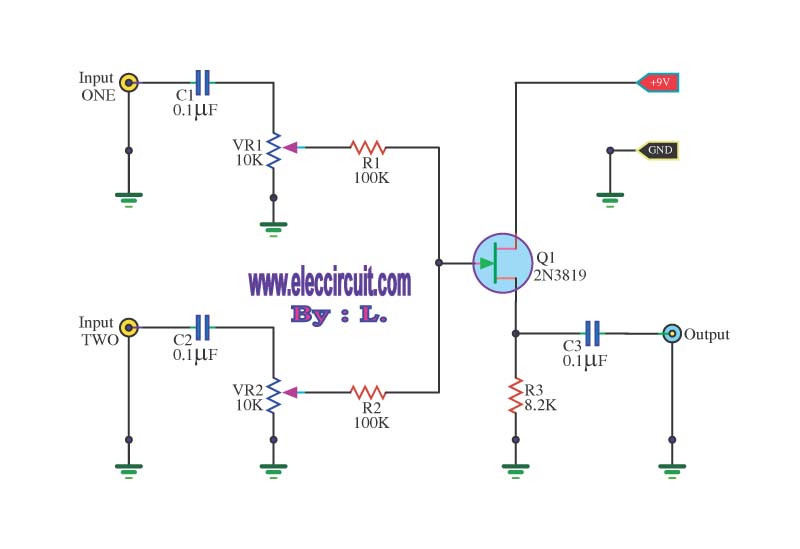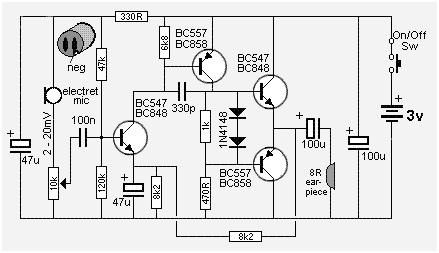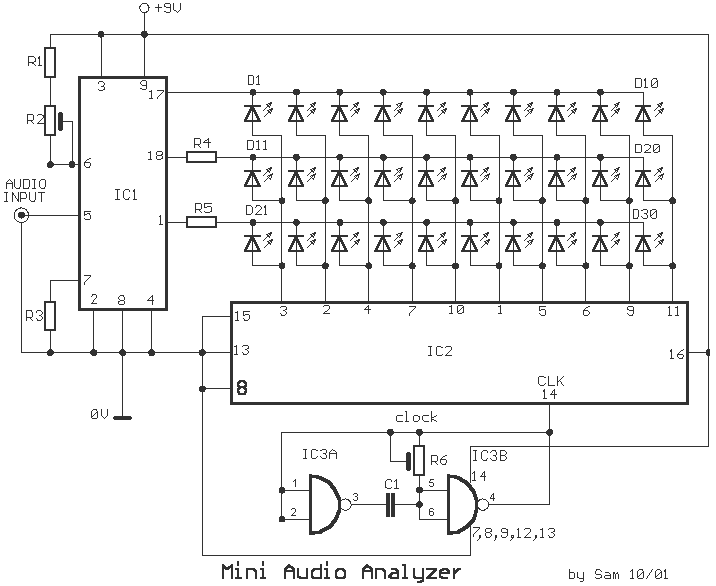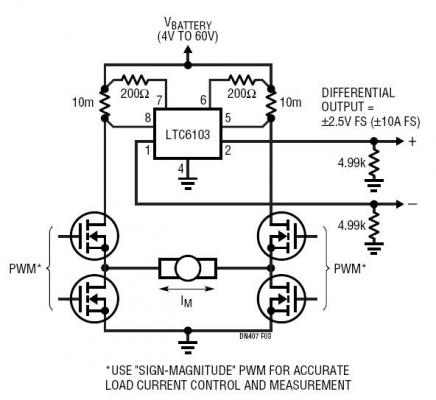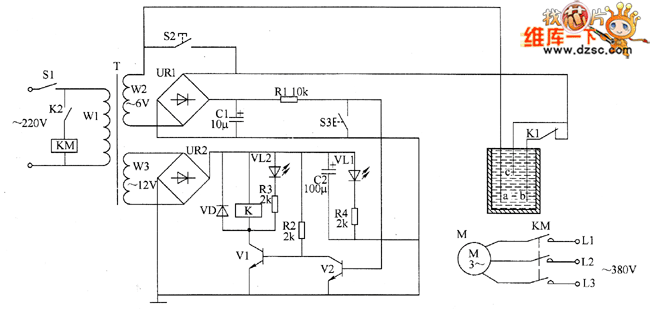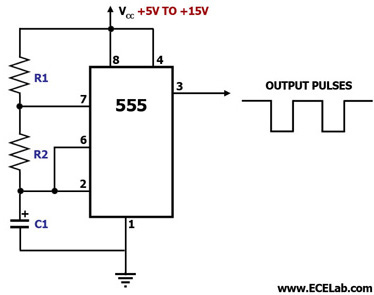
Audio Output Level Indicator
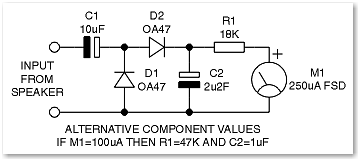
This unit is designed to monitor the audio output level across a loudspeaker during the alignment of radios. A simple passive circuit arrangement has been utilized, as high precision is not required. The circuit functions as a voltage-doubling rectifier that drives a panel meter. The input signal is AC coupled through capacitor C1. Diode D1 maintains the signal so that the negative peaks are at ground potential. The mean level remains above ground, making the polarity of C1 significant. The peak level is rectified by diode D2 and stored in the reservoir capacitor C2. Resistor R1 is selected to provide the necessary calibration with a 250 µA meter movement; alternative component values should be used if a 100 µA meter is employed. The prototype was built on a small piece of plain matrix board, although tag strip or stripboard could also be used. A printed circuit board (PCB) would be excessive for such a straightforward design. The prototype utilized a low-cost 250 µA signal strength meter priced at £3.20, sourced from Maplin (Order Code LB80B). This meter is labeled "SIGNAL" and features an arbitrary scale from 0 to 5, making it suitable for this application. While a higher quality meter could be used, it would not provide any significant advantage. The input can be connected via a two-core speaker cable, with the free end equipped with small crocodile clips for easy attachment to the speaker terminals of the radio being aligned. The unit is intended for connection across a loudspeaker; if the loudspeaker needs to be disconnected due to noise, it should be replaced with an appropriate wirewound resistor. There have been inquiries regarding the availability of OA47 germanium diodes, which are currently listed in the Maplin catalogue (Order Code QH70M, priced at 49p each). An alternative configuration using 10 µF for C1, 2.2 µF for C2, silicon diodes 1N914 for D1 and D2, and a 15 kΩ resistor for R1, along with a 200 µA meter from an old Heathkit Vacuum Tube Voltmeter, has been reported to function effectively. Although silicon diodes might introduce some non-linearity to the scale, this is not critical for the operation of the unit. User feedback indicates satisfaction with the performance of the device.
The audio output level monitoring unit employs a straightforward passive design suitable for radio alignment tasks. The circuit's primary components include capacitors, diodes, and resistors, which work together to provide a reliable indication of the audio signal's strength. The use of AC coupling through capacitor C1 is essential for blocking any DC offset from the input signal, ensuring that only the AC component is processed. Diode D1 serves to rectify the incoming AC signal while maintaining the negative peaks at ground level, which is crucial for accurate mean level detection.
The rectification process is enhanced by diode D2, which captures the peak levels of the audio signal and charges the reservoir capacitor C2. This capacitor acts as a buffer, allowing the panel meter to display a stable reading of the audio output level. The choice of resistor R1 directly affects the calibration of the meter, allowing it to accurately reflect the audio signal's strength as measured in microamperes.
The design's simplicity extends to its construction, allowing for easy assembly on matrix or stripboard. The low-cost meter used in the prototype exemplifies the unit's cost-effective approach while still providing adequate performance for its intended purpose. The option to connect the unit using a two-core speaker cable with crocodile clips facilitates quick and convenient setup during radio alignment procedures.
In terms of component selection, the availability of germanium diodes may present a challenge, but the suggested alternative of silicon diodes such as the 1N914 provides a viable solution without significantly impacting performance. This flexibility in component choice enhances the unit's practicality, making it accessible for users who may not have access to specific parts.
Overall, this audio output level monitoring unit is designed for ease of use and effective performance in radio alignment tasks, making it a valuable tool for electronics enthusiasts and professionals alike.This unit is designed for monitoring the audio output level across a loudspeaker when carrying out alignment of radios. As no great precision is required, a simple passive circuit arrangement has been used. The circuit is a voltage-doubling rectifier driving a panel meter. The input signal is AC coupled via C1. D1 holds the signal so that the nega tive peaks are at ground potential. The mean level is above ground, so the polarity of C1 is important. The peak level is rectified by D2 and stored in reservoir capacitor C2. The value of R1 has been selected to give the required calibration with a 250uA meter movement. If a 100uA is used, the alternative component values should be used. The prototype was constructed using a small piece of plain matrix board. Tag strip or stripboard could be used if preferred. A PCB would be overkill for such a simple design! The meter used on the prototype was a low cost ( £3. 20) 250uA signal strength meter obtained from Maplin (Order Code LB80B). This is marked "SIGNAL" and has an arbitrary scale marked 0 to 5, making it ideal for the purpose. A higher quality meter could be used, but this would offer no real advantage. The input may be bought in via a length of two-core speaker cable. The free end may be fitted with a pair of small crocodile clips for easy connection to the speaker tags in the radio being aligned. The unit is designed for connection across a loudspeaker. If you wish to disconnect the loudspeaker because of the annoying noise, replace it with a suitable wirewound resistor.
Two people have contacted me regarding the availability of the OA47 germanium diodes. These are listed in the current Maplin catalogue (Order Code QH70M, price 49p each). I followed your online article using 10uF for C1, 2. 2uF for C2, silicon diodes 1N914 (I think) for D1 & D2, 15K for R1, and a 200uA meter from and old Heathkit Vacuum Tube Voltmeter. It works just fine. So, if you cannot obtain the germanium diodes easily, try silicon diodes. 1N914 is electrically almost identical to the more common 1N4148 diode. I would have expected silicon diodes to make the scale more non-linear, but this does not really matter much for this unit.
Charlie certainly seems happy with his unit. 🔗 External reference
The audio output level monitoring unit employs a straightforward passive design suitable for radio alignment tasks. The circuit's primary components include capacitors, diodes, and resistors, which work together to provide a reliable indication of the audio signal's strength. The use of AC coupling through capacitor C1 is essential for blocking any DC offset from the input signal, ensuring that only the AC component is processed. Diode D1 serves to rectify the incoming AC signal while maintaining the negative peaks at ground level, which is crucial for accurate mean level detection.
The rectification process is enhanced by diode D2, which captures the peak levels of the audio signal and charges the reservoir capacitor C2. This capacitor acts as a buffer, allowing the panel meter to display a stable reading of the audio output level. The choice of resistor R1 directly affects the calibration of the meter, allowing it to accurately reflect the audio signal's strength as measured in microamperes.
The design's simplicity extends to its construction, allowing for easy assembly on matrix or stripboard. The low-cost meter used in the prototype exemplifies the unit's cost-effective approach while still providing adequate performance for its intended purpose. The option to connect the unit using a two-core speaker cable with crocodile clips facilitates quick and convenient setup during radio alignment procedures.
In terms of component selection, the availability of germanium diodes may present a challenge, but the suggested alternative of silicon diodes such as the 1N914 provides a viable solution without significantly impacting performance. This flexibility in component choice enhances the unit's practicality, making it accessible for users who may not have access to specific parts.
Overall, this audio output level monitoring unit is designed for ease of use and effective performance in radio alignment tasks, making it a valuable tool for electronics enthusiasts and professionals alike.This unit is designed for monitoring the audio output level across a loudspeaker when carrying out alignment of radios. As no great precision is required, a simple passive circuit arrangement has been used. The circuit is a voltage-doubling rectifier driving a panel meter. The input signal is AC coupled via C1. D1 holds the signal so that the nega tive peaks are at ground potential. The mean level is above ground, so the polarity of C1 is important. The peak level is rectified by D2 and stored in reservoir capacitor C2. The value of R1 has been selected to give the required calibration with a 250uA meter movement. If a 100uA is used, the alternative component values should be used. The prototype was constructed using a small piece of plain matrix board. Tag strip or stripboard could be used if preferred. A PCB would be overkill for such a simple design! The meter used on the prototype was a low cost ( £3. 20) 250uA signal strength meter obtained from Maplin (Order Code LB80B). This is marked "SIGNAL" and has an arbitrary scale marked 0 to 5, making it ideal for the purpose. A higher quality meter could be used, but this would offer no real advantage. The input may be bought in via a length of two-core speaker cable. The free end may be fitted with a pair of small crocodile clips for easy connection to the speaker tags in the radio being aligned. The unit is designed for connection across a loudspeaker. If you wish to disconnect the loudspeaker because of the annoying noise, replace it with a suitable wirewound resistor.
Two people have contacted me regarding the availability of the OA47 germanium diodes. These are listed in the current Maplin catalogue (Order Code QH70M, price 49p each). I followed your online article using 10uF for C1, 2. 2uF for C2, silicon diodes 1N914 (I think) for D1 & D2, 15K for R1, and a 200uA meter from and old Heathkit Vacuum Tube Voltmeter. It works just fine. So, if you cannot obtain the germanium diodes easily, try silicon diodes. 1N914 is electrically almost identical to the more common 1N4148 diode. I would have expected silicon diodes to make the scale more non-linear, but this does not really matter much for this unit.
Charlie certainly seems happy with his unit. 🔗 External reference
